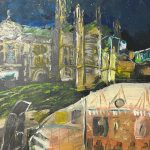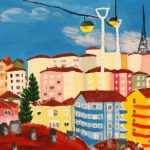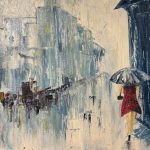Research results and individual creative expression shared the stage at the first Art of Economics Showcase on March 25, 2025.
Held at Max Gluskin House, twenty-seven pieces of art created by graduate students, faculty, staff, and emeriti gave attendees a sample of diverse artistic interests and expressions.
To promote conversation about the connections between art, research and the study of Economics, Professor Stephan Heblich presented the paper State of the Art: Economic Development Through the Lens of Paintings he co-authored with Clément Gorin and Yanos Zylberberg.
The paper is a journey through 500 years of classic artistic masterpieces to decode the layers of meaning embedded in artistic works.
“Artists drew from their contexts, choosing what to represent and embedding their reflection on societal moods and emotions into paintings,” Heblich explained.
Art historians usually interpret paintings by analyzing the artwork itself, the artist and the broader social context. The researchers took a similar approach by developing an algorithm for art analysis. The procedure identifies elements of art and their composition, enabling the analysis of emotional content in paintings. This approach considers individual artist characteristics while also identifying common themes that reflect societal moods.
Inspired by the social history of art, they followed the idea that studying art, artists, and their audience can reveal deeper structural insights about society. They analyzed online collections comprising 545,800 pieces from more than 16,000 artists, sourced from Google Arts and Culture, Wiki-Art, and Wiki-Data and created a neural network to identify the emotions expressed by different painters. They also examined how these emotions relate to the artist’s personal background, their artistic influences and styles, and the historical era. The researchers discovered that the emotional patterns in paintings from about 20 countries, dating back to the 15th century, reflected broader societal moods over time.
The process involved key steps. First, emotions are classified as the algorithm assesses various elements within a painting; colour schemes, composition, and subject matter; to determine the dominant emotion it elicits. Once emotions are identified, a contextual mapping links them to varied factors such as the artist’s characteristics, the style and medium used, and the painting’s geographical and temporal context. Lastly, by analyzing newly generated data, they look at how these emotional categories are distributed and change over time and space, which enables them to draw conclusions about correlations between economic indicators and the emotional content of art. This approach uses machine learning methods to track changes in artistic emotional expressions and link them to important economic transformations like the Industrial Revolution, the Renaissance, the Reformation and the Enlightenment.
“Our findings suggest that negative emotions such as fear and sadness are associated with war events and pandemics, while positive emotions, especially enjoyment, track the hockey stick growth in GDP experienced by most European countries,” explained Heblich.
Greater conflict in the emotions expressed by different painters living at the same time and in the same region is strongly correlated with wealth inequality.
“We interpret this disagreement as reflecting variation in economic circumstances, leading to a wider spread in both positive and negative emotions,” Heblich said.
Another correlation between paintings and economic development is noted in trade shocks following the discovery of new continents or trade routes which initially increase the element of fear in the pieces but raise enjoyment in the long run.
“Finally, we find that temperature variation is also reflected in emotional expression. Colder temperatures are associated with fear and sadness, likely linked to food shortages during the Little Ice Age, while warmer-than-average temperatures are linked to contentment,” concluded Heblich.
Many of the community creations exhibited at the event were connected to events in the artists’ work at the department. Third-year PhD student Olivia Yu, for example, painted the piece Orangier in her first year as a way of managing anxiety about writing her comps that June. The painting has become her favourite piece.
“This art exhibition meant a lot to me because it came from an intention to celebrate the people who make up this department,” she said.
There is interest in further explorations of the connection between art and economics and the showcase may become an annual event as a result.
“There are many talented artists in our learning community,” said Professor Ettore Damiano, Chair of the Department of Economics. “We got to experience a unique evening of connection with art and people.”
Return to the Department of Economics website.
Scroll more news.











